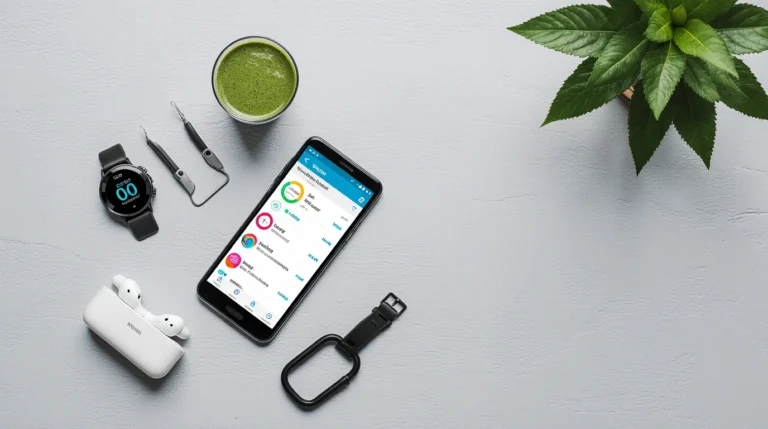5 Powerful AI Prompts for Immediate Stress Relief
In our always-on culture, is it any surprise that global stress levels are at a record high? A recent Gallup poll found that 44% of adults worldwide felt a lot of stress the previous day. While we often look for external solutions, one of the most powerful tools for managing these feelings might already be open in another tab on your browser. This practical guide is part of our comprehensive series on AI for wellness. It is designed to show you how to use specific AI prompts for stress relief, turning your familiar chatbot into a powerful ally for your mental well-being and a practical tool for AI for mindfulness.
Beyond Productivity: Using AI for Your Mental Wellness
We’ve become accustomed to using AI for productivity—drafting emails, summarizing reports, even planning our nutrition. But its potential extends far deeper, into the realm of our own mental and emotional landscape. Using ChatGPT for mental wellness isn’t about replacing professional therapy; it’s about having an accessible, non-judgmental space to process thoughts, gain perspective, and build healthier mental habits.
Why Turn to an AI for Stress Relief?
While these prompts work with any general chatbot, there are also many specialized top health AI apps designed specifically for mindfulness and mental clarity. The benefits are uniquely suited to our modern lives:
- Immediate Accessibility: Stress doesn’t strike on a schedule. An AI is available 24/7, providing a space to unload your thoughts the moment they become overwhelming.
- Absolute Privacy: The fear of judgment can prevent us from being truly open. An AI offers an impartial, confidential sounding board, allowing for raw honesty without social repercussions.
- Structured Thinking: A well-designed prompt can guide your thinking in a structured way, helping you move from a chaotic state of mind to a clear, actionable perspective. It acts as a facilitator for your own introspection.
Actionable AI Prompts for Immediate Stress Relief

Here are five distinct, powerful prompts you can copy, paste, and adapt. Each is based on established psychological principles to help you navigate different facets of stress.
1. The “Brain Dump” Prompt: Declutter Your Mind
The Principle: Getting thoughts out of your head and onto a page (or screen) reduces cognitive load and provides instant mental space.
When to Use It: When your mind is racing with a tangled mess of worries, tasks, and emotions, and you don’t know where to start.
The Prompt:
Act as a supportive listener. I am going to perform a “brain dump” of everything that is currently on my mind, causing me stress. Do not offer solutions yet. Just listen and then categorize my thoughts into three simple lists:
1. Things I can control.
2. Things I cannot control.
3. Tasks and to-do items.
Here I go: [Write everything on your mind here, without filtering or organizing.]
2. The “Cognitive Reframing” Prompt: Challenge Negative Thoughts
The Principle: Based on Cognitive Behavioral Therapy (CBT), this technique involves identifying and challenging irrational or negative thought patterns.
When to Use It: When you find yourself stuck in a loop of self-criticism, catastrophizing, or negative assumptions.
The Prompt:
Act as a compassionate cognitive coach. I am struggling with a negative thought.
My thought is: “[State the negative thought, e.g., ‘I am going to fail this presentation and everyone will think I’m incompetent.’]”
Please guide me to challenge this thought by asking me three questions based on CBT principles, such as:
1. What is the evidence that supports this thought? What is the evidence against it?
2. What is a more balanced, alternative way of looking at this situation?
3. What is the worst that could happen, and could I survive it? What is the best that could happen?
3. The “Mindful Moment” Prompt: Anchor Yourself in the Present
The Principle: Mindfulness is the practice of bringing your attention to the present moment without judgment. It’s a powerful way to reduce anxiety with AI by breaking the cycle of worrying about the future or ruminating on the past.
When to Use It: When you feel your anxiety rising, your heart beating faster, or your thoughts spiraling.
The Prompt:
Act as a gentle mindfulness guide. I am feeling overwhelmed and need to ground myself in the present moment. Please guide me through a short, 2-minute mindfulness exercise. Describe what I should focus on with my senses (sight, sound, touch, smell, taste) right where I am. Use calm and simple language.
4. The “Action Plan” Prompt: Move from Overwhelm to Action
The Principle: Stress often stems from a feeling of powerlessness. Breaking a large, overwhelming problem down into small, manageable steps can restore a sense of control. This same principle applies to other areas of life; for example, you can reduce dietary stress when you create a custom meal plan with AI.
When to Use It: When a big project, a difficult decision, or a complex problem is causing you significant stress.
The Prompt:
Act as a practical problem-solving partner. I am feeling overwhelmed by this situation: [Clearly describe the large problem, e.g., “I have to find a new apartment in the next month and it feels impossible.”]
Please help me break this down. Ask me clarifying questions if you need to, and then create a simple, step-by-step action plan with just 3-4 small, concrete “first steps” that I can take to get started.
5. The “Gratitude” Prompt: Shift Your Perspective
The Principle: Gratitude practice is scientifically linked to increased happiness and reduced stress. It actively shifts your focus from what’s wrong to what’s right. Managing daily stress is crucial, as it directly impacts your sleep quality, which is essential for mental recovery. Understanding this connection is the first step to unlocking better sleep.
When to Use It: At the end of a tough day, or anytime you feel a wave of negativity or cynicism.
The Prompt:
Act as a guide for a gratitude practice. Prompt me to identify three specific things that went well today, no matter how small. For each one, ask me a follow-up question to help me reflect on why it was meaningful.
Practical Tips for Using These Prompts Effectively
Create a Routine Bookmark these prompts or save them in a note-taking app. The more you use them, the more natural the process will become. Try using the Gratitude Prompt every evening for a week and see how you feel.
Be Honest and Open The more detail and honesty you provide in your part of the prompt, the more insightful and helpful the AI’s response will be. Remember, it’s a judgment-free zone.
Iterate and Personalize These prompts are templates. Feel free to modify them. If a certain question doesn’t resonate, ask the AI to rephrase it. You are in control of the conversation with your mental health chatbot. The quality of the conversation often comes down to your understanding of Heart Rate Variability (HRV) and other bio-signals that reflect your stress levels.
Frequently Asked Questions (FAQ)
Is it safe to share personal feelings with an AI?
Reputable AI companies have privacy policies in place, but you should always be mindful. Avoid sharing highly sensitive, personally identifiable information like your full name, address, or financial details. Think of it as a private journal, not a secure medical record.
How is this different from talking to a human therapist?
This is a critical distinction. An AI is a tool for self-reflection and thought organization. It does not have consciousness, empathy, or clinical training. A human therapist provides a real therapeutic relationship, clinical expertise, and can diagnose and treat complex mental health conditions. An AI is a supplement, not a replacement.
Can these prompts help with severe anxiety or depression?
No. These AI prompts for stress relief are designed for managing everyday stress and promoting general mental wellness. For clinical anxiety, depression, or any severe mental health condition, it is essential to seek help from a qualified healthcare professional.
Disclaimer: This article is for informational and educational purposes only. It is not a substitute for professional medical advice, diagnosis, or treatment. Always seek the advice of your physician or other qualified health provider with any questions you may have regarding a medical condition.








5 Comments